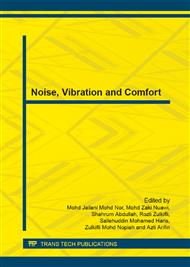p.3
p.9
p.14
p.20
p.25
p.30
p.35
p.40
Ride Evaluation of Vehicle Suspension Employing Non-Linear Inerter
Abstract:
Inerter is a recent element in suspension systems with the property that the generated force is proportional to the relative acceleration between its two terminals, which is similar to the way a spring reacts to relative displacement and a damper to relative velocity. This paper presents the analysis of a non-linear inerter working in parallel to passive spring and damper of a vehicle suspension to evaluate its effect on vehicles ride. The non-linear inerter was theoretically capable of switching between on and off states depending on whether or not the suspension deflection was beyond a specified free play. In the study, this behavior was represented mathematically as control law which depended on the relative displacement between the sprung and unsprung masses. A mathematical quarter vehicle model incorporating the non-linear inerter was simulated in MATLAB/Simulink to determine the vehicle responses due to road input in the form of step profile for different combinations of free play and inerters on-state proportionality constant called the inertance. Results showed improvements in vehicle ride comfort, as demonstrated by the lower root-mean-squared sprung mass accelerations compared to the ordinary passive suspension with only spring and damper. Additionally, implementation of non-linear inerter gave lower percentage overshoot to step input, indicating better transient response than ordinary passive suspension.
Info:
Periodical:
Pages:
9-13
Citation:
Online since:
December 2013
Authors:
Keywords:
Price:
Сopyright:
© 2014 Trans Tech Publications Ltd. All Rights Reserved
Share:
Citation:


